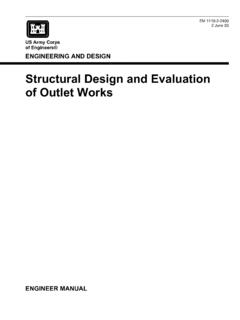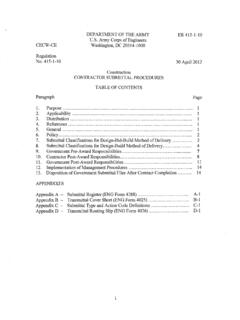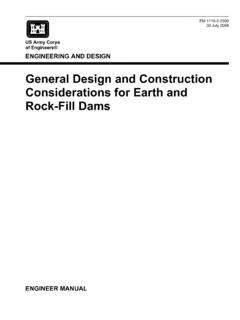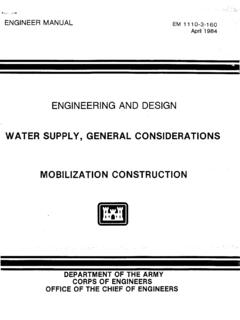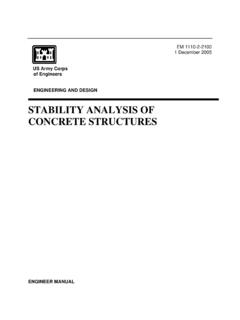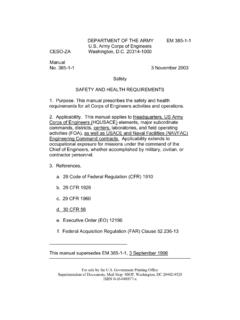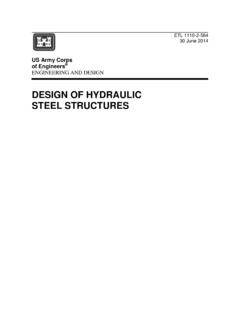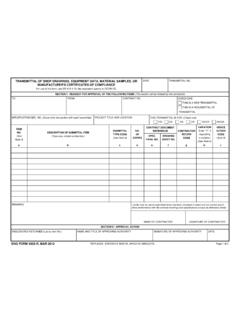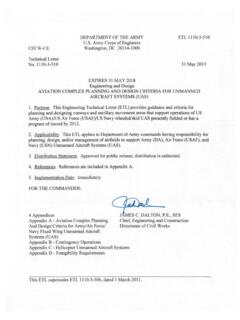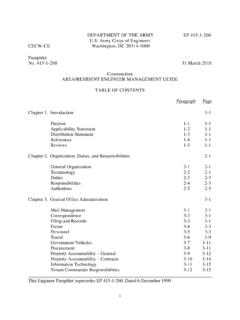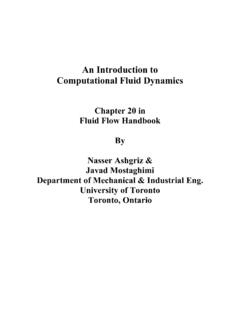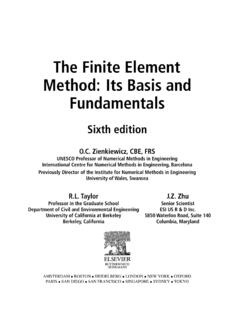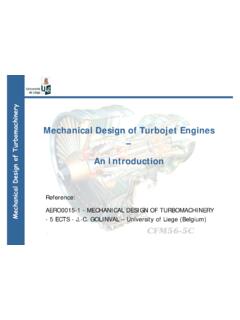Transcription of Slope Stability - United States Army
1 EM 1110-2-1902. 31 Oct 2003. US Army Corps of Engineers . ENGINEERING AND DESIGN. Slope Stability ENGINEER MANUAL. AVAILABILITY. Electronic copies of this and other Army Corps of Engineers (USACE) publications are available on the Internet at This site is the only repository for all official USACE engineer regulations, circulars, manuals, and other documents originating from HQUSACE. Publications are provided in portable document format (PDF). DEPARTMENT OF THE ARMY EM 1110-2-1902. Army Corps of Engineers CECW-EW Washington, DC 20314-1000. Manual No. 1110-2-1902 31 October 2003. Engineering and Design Slope Stability . 1. Purpose. This engineer manual (EM) provides guidance for analyzing the static Stability of slopes of earth and rock-fill dams, slopes of other types of embankments, excavated slopes, and natural slopes in soil and soft rock. methods for analysis of Slope Stability are described and are illustrated by examples in the appendixes. Criteria are presented for strength tests, analysis conditions, and factors of safety.
2 The criteria in this EM are to be used with methods of Stability analysis that satisfy all conditions of equilibrium. methods that do not satisfy all conditions of equilibrium may involve significant inaccuracies and should be used only under the restricted conditions described herein. 2. Applicability. This EM is applicable to all USACE elements and field operating activities having responsibility for analyzing Stability of slopes. 3. Distribution Statement. This publication is approved for public release; distribution is unlimited. 4. Scope of the Manual. This manual is intended to guide design and construction engineer, rather than to specify rigid procedures to be followed in connection with a particular project. FOR THE COMMANDER: 7 Appendixes MICHAEL J. WALSH. (See Table of Contents) Colonel, Corps of Engineers Chief of Staff This manual supersedes EM 1110-2-1902, 1 April 1970. DEPARTMENT OF THE ARMY EM 1110-2-1902. Army Corps of Engineers CECW-EW Washington, DC 20314-1000. Manual No.
3 1110-2-1902 31 October 2003. Engineering and Design Slope Stability . Subject Paragraph Page Chapter 1. Introduction Purpose and Scope ..1-1 1-1. Applicability ..1-2 1-1. 1-1. Notation and 1-1. Basic Design Considerations ..1-5 1-1. Stability Analysis and Design 1-4. Unsatisfactory Slope 1-5. Chapter 2. Design Considerations 2-1. Aspects Applicable to all Load 2-2. Analyses of Stability during Construction and at the End of Construction ..2-3 2-9. Analyses of Steady-State Seepage 2-10. Analyses of Sudden Drawdown Stability ..2-5 2-11. Analyses of Stability during Earthquakes ..2-6 2-12. Chapter 3. Design Criteria 3-1. New Embankment Dams ..3-2 3-3. Existing Embankment 3-3. Other 3-4. Chapter 4. Calculations and Presentations Analysis 4-1. Verification of Computer Analyses and 4-1. Presentation of the Analysis and Results ..4-3 4-7. Appendix A. References Appendix B. Notation i EM 1110-2-1902. 31 Oct 03. Subject Paragraph Page Appendix C. Stability Analysis Procedures Theory and Limitations Appendix D.
4 Shear Strength Characterization Appendix E. Chart Solutions for Embankment Slopes Appendix F. Example Problems and Calculations Appendix G. Procedures and Examples for Rapid Drawdown ii EM 1110-2-1902. 31 Oct 03. Chapter 1. Introduction 1-1. Purpose and Scope This engineer manual (EM) provides guidance for analyzing the static Stability of slopes of earth and rock-fill dams, slopes of other types of embankments, excavated slopes, and natural slopes in soil and soft rock. methods for analysis of Slope Stability are described and are illustrated by examples in the appendixes. Criteria are presented for strength tests, analysis conditions, and factors of safety. The criteria in this EM are to be used with methods of Stability analysis that satisfy all conditions of equilibrium. methods that do not satisfy all conditions of equilibrium may involve significant inaccuracies and should be used only under the restricted conditions described herein. This manual is intended to guide design and construction engineers, rather than to specify rigid procedures to be followed in connection with a particular project.
5 1-2. Applicability This EM is applicable to all USACE elements and field operating activities having responsibility for analyzing Stability of slopes. 1-3. References Appendix A contains a list of Government and non-Government references pertaining to this manual. Each reference is identified in the text by either the designated publication number or by author and date. 1-4. Notation and Glossary Symbols used in this manual are listed and defined in Appendix B. The notation in this manual corresponds whenever possible to that recommended by the American Society of Civil Engineers. 1-5. Basic Design Considerations a. General overview. Successful design requires consistency in the design process. What are considered to be appropriate values of factor of safety are inseparable from the procedures used to measure shear strengths and analyze Stability . Where procedures for sampling, testing, or analysis are different from the procedures described in this manual, it is imperative to evaluate the effects of those differences.
6 B. Site characterization. The Stability of dams and slopes must be evaluated utilizing pertinent geologic information and information regarding in situ engineering properties of soil and rock materials. The geologic information and site characteristics that should be considered include: (1) Groundwater and seepage conditions. (2) Lithology, stratigraphy, and geologic details disclosed by borings and geologic interpretations. (3) Maximum past overburden at the site as deduced from geological evidence. (4) Structure, including bedding, folding, and faulting. (5) Alteration of materials by faulting. 1-1. EM 1110-2-1902. 31 Oct 03. (6) Joints and joint systems. (7) Weathering. (8) Cementation. (9) Slickensides. (10) Field evidence relating to slides, earthquake activity, movement along existing faults, and tension jointing. c. Material characterization. In evaluating engineering properties of soil and rock materials for use in design, consideration must be given to: (1) possible variation in natural deposits or borrow materials, (2) natural water contents of the materials, (3) climatic conditions, (4) possible variations in rate and methods of fill placement, and (5) variations in placement water contents and compacted densities that must be expected with normal control of fill construction.
7 Other factors that must be considered in selecting values of design parameters, which can be evaluated only through exercise of engineering judgment, include: (1) the effect of differential settlements where embankments are located on compressible foundations or in narrow, deep valleys, and (2) stress-strain compatibility of zones of different materials within an embankment, or of the embankment and its foundation. The Stability analyses presented in this manual assume that design strengths can be mobilized simultaneously in all materials along assumed sliding surfaces. d. Conventional analysis procedures (limit equilibrium). The conventional limit equilibrium methods of Slope Stability analysis used in geotechnical practice investigate the equilibrium of a soil mass tending to move downslope under the influence of gravity. A comparison is made between forces, moments, or stresses tending to cause instability of the mass, and those that resist instability. Two-dimensional (2-D) sections are analyzed and plane strain conditions are assumed.
8 These methods assume that the shear strengths of the materials along the potential failure surface are governed by linear (Mohr-Coulomb) or nonlinear relationships between shear strength and the normal stress on the failure surface. (1) A free body of the soil mass bounded below by an assumed or known surface of sliding (potential slip surface), and above by the surface of the Slope , is considered in these analyses. The requirements for static equilibrium of the soil mass are used to compute a factor of safety with respect to shear strength. The factor of safety is defined as the ratio of the available shear resistance (the capacity) to that required for equilibrium (the demand). Limit equilibrium analyses assume the factor of safety is the same along the entire slip surface. A value of factor of safety greater than indicates that capacity exceeds demand and that the Slope will be stable with respect to sliding along the assumed particular slip surface analyzed. A value of factor of safety less than indicates that the Slope will be unstable.
9 (2) The most common methods for limit equilibrium analyses are methods of slices. In these methods , the soil mass above the assumed slip surface is divided into vertical slices for purposes of convenience in analysis. Several different methods of slices have been developed. These methods may result in different values of factor of safety because: (a) the various methods employ different assumptions to make the problem statically determinate, and (b) some of the methods do not satisfy all conditions of equilibrium. These issues are discussed in Appendix C. e. Special analysis procedures ( finite element, three-dimensional (3-D), and probabilistic methods ). (1) The finite element method can be used to compute stresses and displacements in earth structures. The method is particularly useful for soil-structure interaction problems, in which structural members interact with a soil mass. The Stability of a Slope cannot be determined directly from finite element analyses, but the 1-2. EM 1110-2-1902.
10 31 Oct 03. computed stresses in a Slope can be used to compute a factor of safety. Use of the finite element method for Stability problems is a complex and time-consuming process. finite element analyses are discussed briefly in Appendix C. (2) Three-dimensional limit equilibrium analysis methods consider the 3-D shapes of slip surfaces. These methods , like 2-D methods , require assumptions to achieve a statically determinate definition of the problem. Most do not satisfy all conditions of static equilibrium in three dimensions and lack general methodologies for locating the most critical 3-D slip surface. The errors associated with these limitations may be of the same magnitude as the 3-D effects that are being modeled. These methods may be useful for estimating potential 3-D effects for a particular slip surface. However, 3-D methods are not recommended for general use in design because of their limitations. The factors of safety presented in this manual are based on 2-D analyses. Three-dimensional analysis methods are not included within the scope of this manual.
